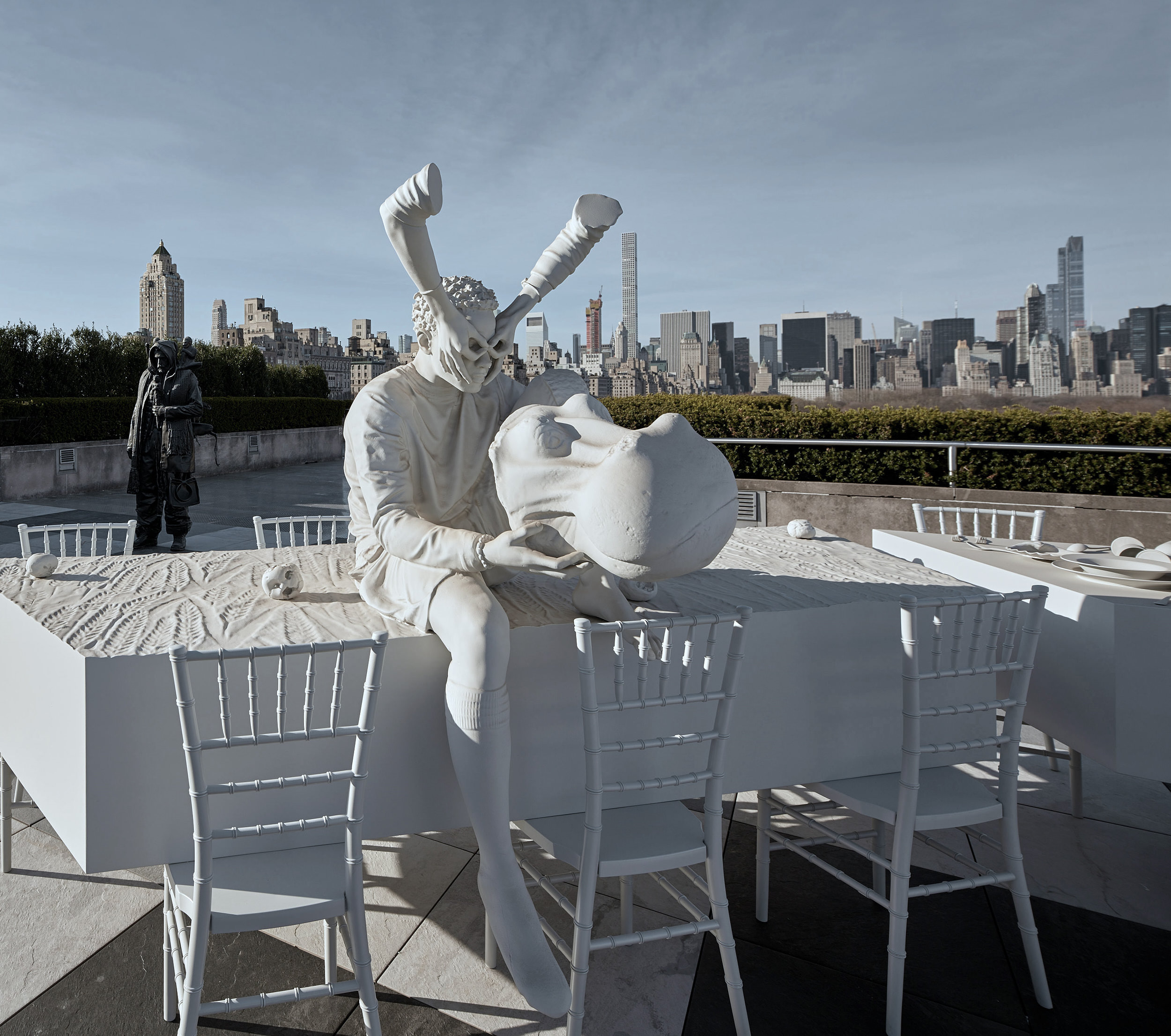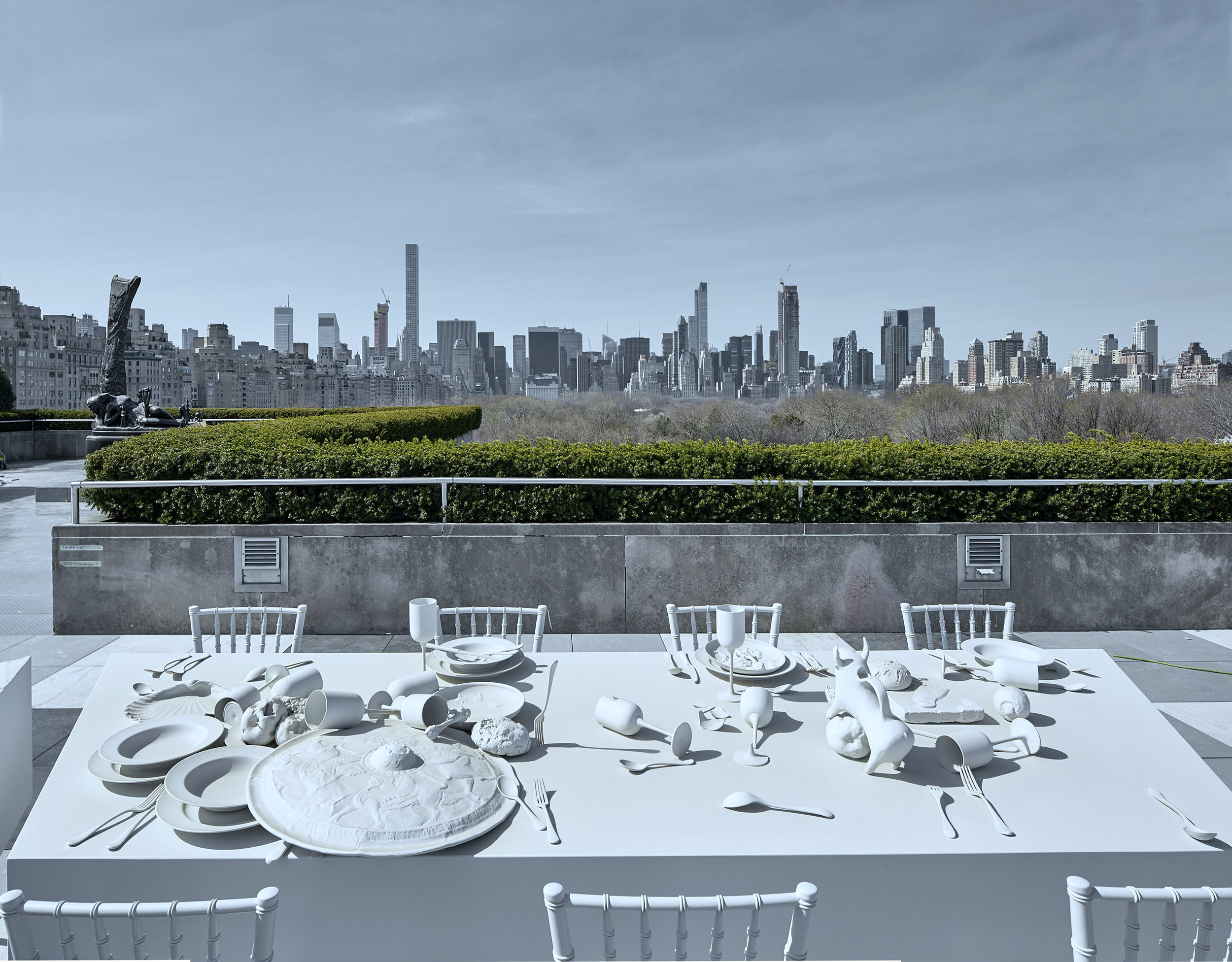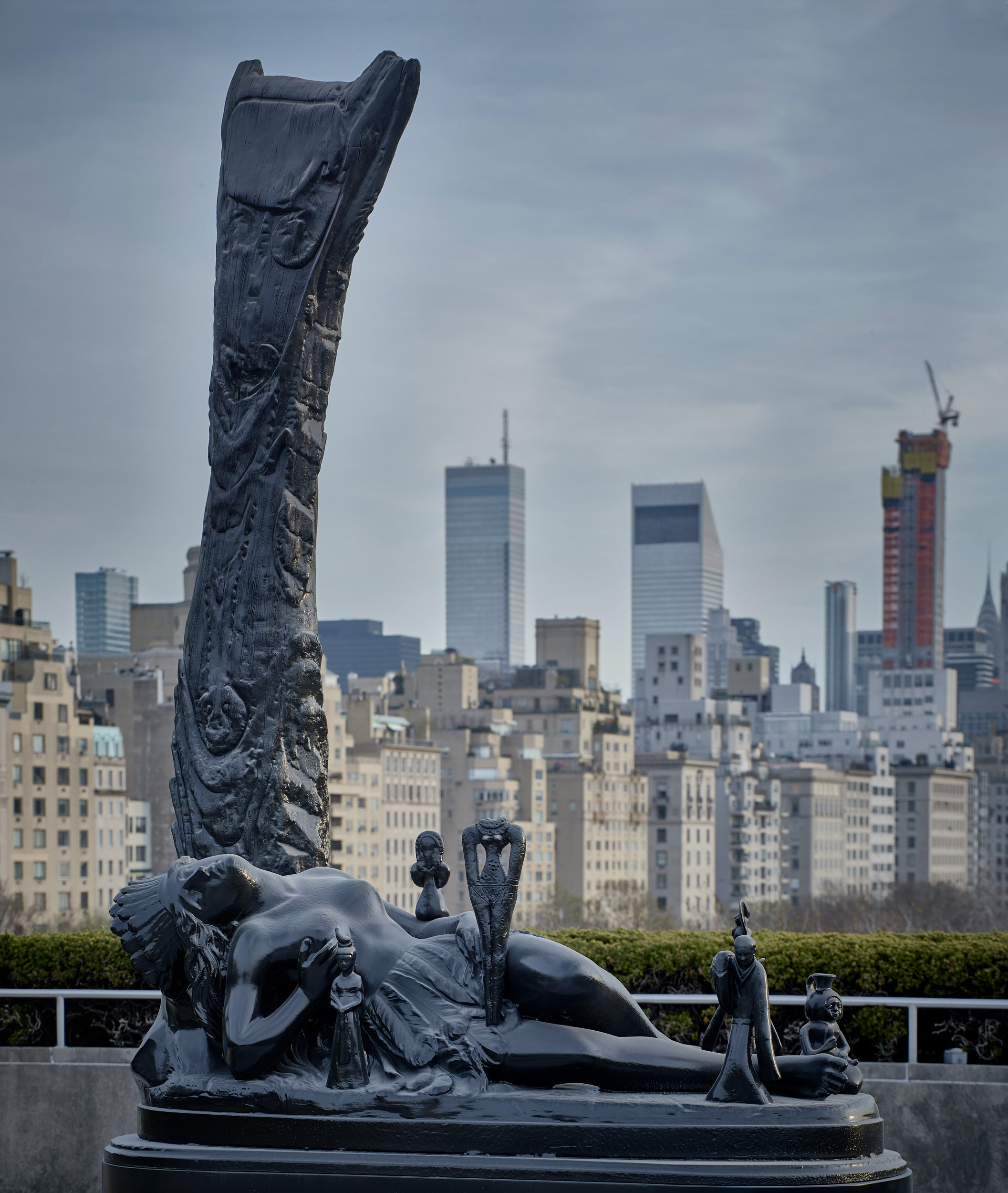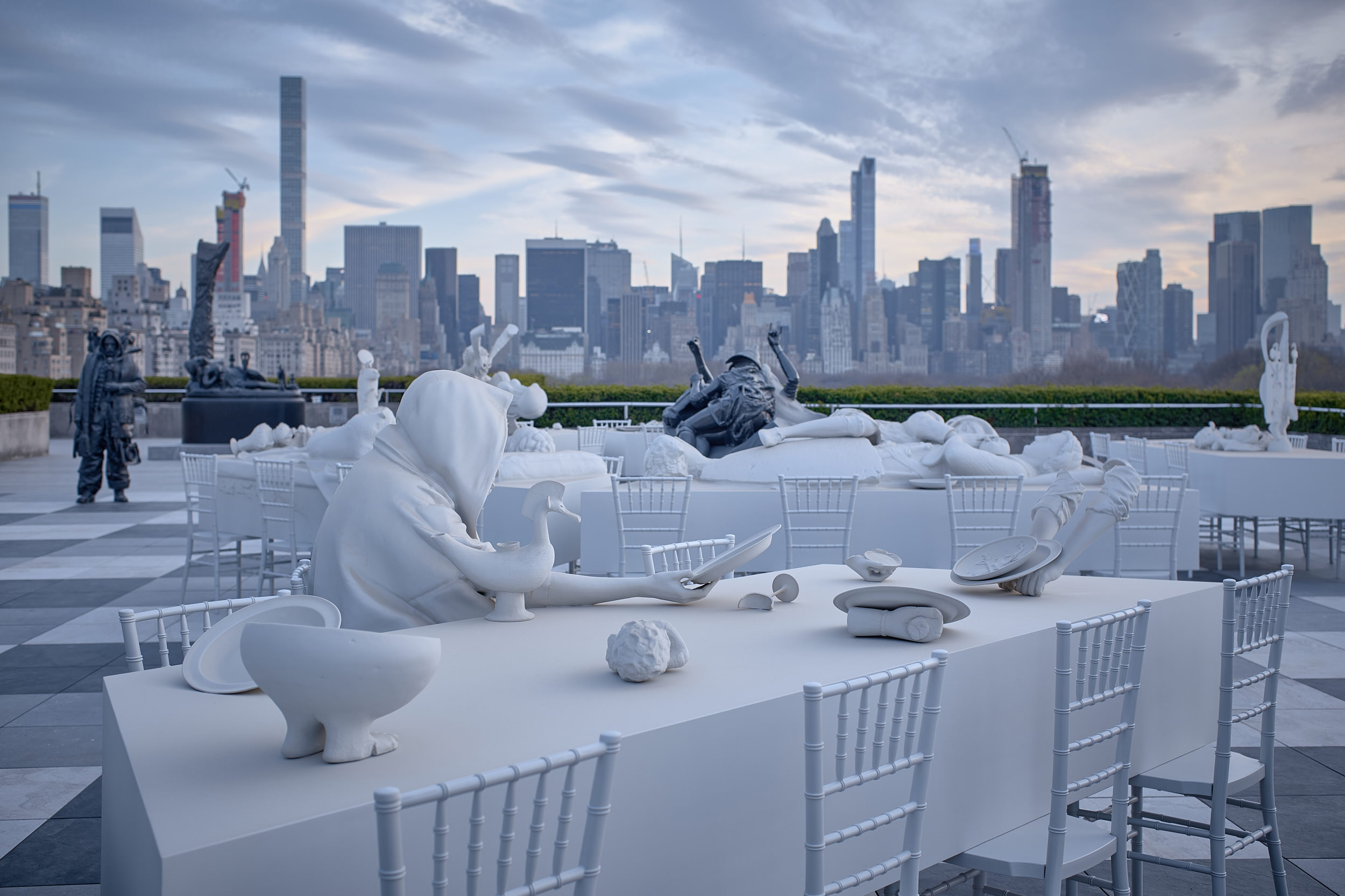Nine white banquet tables stand atop the Metropolitan Museum of Art, arranged as if for an elaborate midsummer dinner party or rooftop gala. Topped with glassware and flanked by neatly spaced chairs, the roof seems poised to receive the revelry that flocks to it on summer evenings, yet the tablecloths are unnervingly static and a thin layer of dirt coats the entire tableau. The scene is set not for the city’s contemporary revelers but for a decidedly more historic bacchanal, to which only those who reside permanently in the galleries below are invited.
For this year’s rooftop commission, the Argentinian artist Adrián Villar Rojas has called upon and gathered close to 100 works from the museum’s encyclopedic collection at an elaborate banquet of his own making, titled “The Theater of Disappearance.” Villar Rojas—perhaps best known for his visibly disintegrating installations and totemic works—has here forgone his characteristic use of unfired clay and its entropic qualities for photogrammetry software and the more durable medium of polyurethane foam. With the help of the museum’s photography department, works such as a New Kingdom bust of Tutankhamun, a 13th-century French knight from the Cloisters, and ancient Persian vessels dating from the 1st century B.C. were 3D scanned and amalgamated into an array of freestanding and tabletop sculptures. Human figures were mapped and replicated in life-size, with members of the Met’s curatorial staff, Villar Rojas’ installation team, and the artist himself serving as models. As is the artist’s wont, the entirety of the rooftop has also been redesigned, with meticulous attention given to the checkerboard floor and extended to the pergola that stretches across the bar.

The result is a surreal diorama of people and objects that engage both decorously and contentiously with one another, freed from categorical constraints yet still laden with the cultural and hierarchical narratives that are laced throughout the museum. One human figure perches atop a table, his face covered by a mask of sorts made by two disembodied arms while his hands cradle a replica of an Egyptian hippopotamus head from the 14th-century B.C. Nearby, a stoic looking man grasping a saber from the museum’s Arms and Armor department appears caught in the whispered crossfire between a pre-Columbian figure on one shoulder and a Hellenistic sculpture on the other. Further afield lies a replica of Mexican Girl Dying, protectively flanked by a carved house post from Papua New Guinea and Ancient Chinese female figurines. On the other extreme, one of the tables features Chester French’s Mourning Victory from the American Wing in repose, only here she is being kicked in the face by a rambunctious figure.
Villar Rojas’s most memorable site-specific and fantastical installations have until this point largely utilized unfired clay, with the decay inherent to this medium creating totemic works that appeared to be instant ruins of a post-apocalyptic future. While the installation at the Met may appear to eschew this aesthetic, it remains closely aligned with Villar Rojas’ interest in multiverses and in reimagining consequential works in art history. His first exhibition at Marian Goodman Gallery in 2015 featured an enlarged, concrete replica of Michelangelo’s David. Laced with cracks and repositioned as a reclining nude, it questioned the sanctity of monumental sculptures and imagined how these works would operate in an end of days or parallel existence. The hybrid structures in Theater of Disappearance, though noticeably devoid of structural decay, similarly entreat viewers to reconsider artworks that have been reconfigured and released from the confines of art historical classifications.

Adrián Villar Rojas, The Roof Garden Commission: Adrián Villar Rojas, The Theater of Disappearance Installation view, The Metropolitan Museum of Art, 2017. Courtesy of the artist; Marian Goodman Gallery; and Kurimanzutto, Mexico City Photographed by Jörg Baumann.
The artist’s use of banquet tables also recalls his other meticulous installations comprised of detritus and organic materials that examined archival practices. Both “Fantasma” at the Moderna Museet (2015) and “Today We Reboot the Planet” at the Serpentine Gallery (2013) featured tabletop or shelved displays of evenly spaced artifacts in varying states of decay – fruits, gourds, cracked containers, and stray running shoes were interspersed with disintegrating figurines of people. Villar Rojas’ diligent arrangement of objects and organic entities appeared to adhere to an underlying, imperceptible logic, thereby highlighting the frailty of accepted systems of classification by observing and complying with another.
This process of decontextualizing and synthesizing various objects from throughout the Met’s catalogued collections is thus not new for Villar Rojas, and reflects the artist’s interest in reconfiguring spatial and temporal boundaries. In lieu of structurally unstable installations that combine layers of organic material with the detritus of contemporary life, however, here he has chosen to reintroduce art historical artifacts and human figures which have been rendered intact and left unsupervised at an elaborately set dinner. Visible decay is nowhere to be found – although whether the roof is set for the last party on Earth or first of a new, parallel era is a different matter altogether.

Adrián Villar Rojas, The Roof Garden Commission: Adrián Villar Rojas, The Theater of Disappearance Installation view, The Metropolitan Museum of Art, 2017. Courtesy of the artist; Marian Goodman Gallery; and Kurimanzutto, Mexico City Photographed by Jörg Baumann.
“The Theater of Disappearance” is on view on the Iris and B. Gerald Cantor Roof Garden through October 29, 2017.

Adrián Villar Rojas, The Roof Garden Commission: Adrián Villar Rojas, The Theater of Disappearance Installation view, The Metropolitan Museum of Art, 2017. Courtesy of the artist; Marian Goodman Gallery; and Kurimanzutto, Mexico City Photographed by Jörg Baumann.









